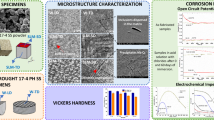Abstract
The critical iodine concentration (Ccr) is determined for steel KhNS-4 (steel OKH16N15M3B after vacuum remelting and and microalloying with Sc) at 923°K to assess the feasibility of its use as a jacket material for the fuel cells of fast reactors. The value of Ccr is established from criteria of residual deformation at failure, longevity, and creep rate under a given stress. Experiments are conducted under ordinary and in reactor conditions. It is noted that creep rate is the most sensitive criterion. It increases sharply as the iodine concentration reaches values of ≈ 10–15 mg/cm2, depending on the stress level, whose growth is accompanied by an increase in the value of Ccr It is demonstrated that radiation damage improves resistance to corrosion cracking. It is concluded that the Ccr values obtained exceed the corrodent concentration actually obtained by many times.
Similar content being viewed by others
Literature cited
M. P. Zeidlits, L. S. Ozhiogov, A. A. Parkhomenko, et al., “Dynamic strain aging of irradiated steel OKh16N15M3B alloyed with scandium,” Vopr. At. Nauki Tekh., Ser. Fiz. Radiats. Povrezh. Radiats. Materialoved., No. 2(56), 12–15 (1991).
V. M. Alyab'ev, L. V. Budanova, L. N. Kuz'minykh, et al., “Study of the thermal creep of steels 00Kh16N15M3B and KhNS-4,” ibid, No. r(3), 69–80 (1988).
V. F. Zelenskii, I. M. Neklyudov, L. S. Ozhigov, et al., “Reducing the effects of the radiation embrittlement and radiation creep of steels and alloys by microalloying with rare-earth metals,” International Conference on Radiation Material Science [in Russian], No. 1 (1990), pp. 175–179.
V. F. Zelenskii and I. M. Neklyudov, “Effect of rare-earth elements on the radiation resistance of materials,” ibid, No. 2 (1990), pp. 45–57.
GOST 10145-81. Metals. Methods of Test for Long-term Strength [in Russian], effective 1 July 1982.
GOST 3248-81. Metals. Methods of Creep Testing [in Russian], effective 1 July 1982.
G. S. Pisarenko and V. N. Kiselevskii, Strength and Plasticity of Materials in Radiation Fluxes [in Russian], Naukova Dumka, Kiev (1979).
V. N. Kiselevskii, Strength of Structural Materials in Nuclear Reactors [in Russian], Naukova Dumka. Kiev (1990).
A. K. Miller, H. Osken, and A. Tasooji, “Iodine stress corrosion of zircaloy: laboratory data, a phenomenological model, and prediction of in-reactor behavior,” J. Nucl. Mater.,99, 254–268 (1981).
Author information
Authors and Affiliations
Additional information
Translated from Problemy Prochnosti, No. 12, pp. 12–17, December, 1993.
Rights and permissions
About this article
Cite this article
Kiselevskii, V.N., Kovalev, V.V., Neklyudov, I.M. et al. Corrosion-cracking resistance of austenitic stainless steel under stress in an iodine medium. Strength Mater 25, 864–869 (1993). https://doi.org/10.1007/BF00774631
Received:
Issue Date:
DOI: https://doi.org/10.1007/BF00774631




